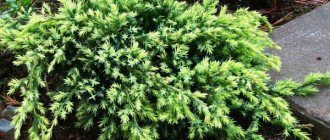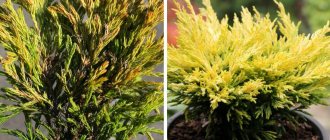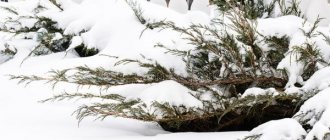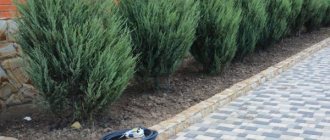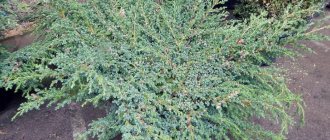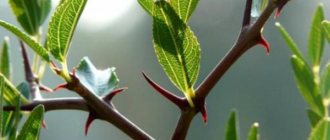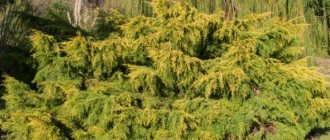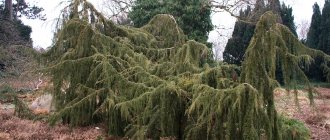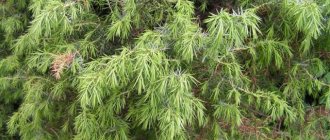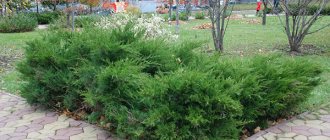Gardeners-breeders have made changes to the natural diversity of juniper varieties and added new varieties of ornamental conifers to the list of plants. Juniper Stricta is one of these artificially bred varieties. It has captivated gardeners around the world with its unpretentiousness and attractive appearance. Blue-green “cones” of juniper add solemnity and grandeur to the decoration of the site.
Description of Chinese juniper Stricta
Chinese juniper from the Cypress family is an evergreen coniferous tree. The Strict variety is a dwarf form of culture with a pyramidal symmetrical crown. The species is classified as dioecious. Male specimens are more elongated, columnar, the branches are located at angles of 450 relative to the trunk. Female representatives form a slightly spreading crown. The species is perennial, the duration of the biological cycle is more than 150 years.
The external characteristics of juniper chinensis Stricta are as follows:
- The branches are upright, thin, rounded. Forms a dense compact crown. The location of the first circle is low, the stem is short.
- The stems are light brown with a rough surface, the shoots are thin and green.
- At the initial stage, the needles are scaly, then they become needle-shaped, triangular with sharp, but not prickly, tips.
- The color of the needles is light green with a blue tint; in the fall the needles turn dark silver.
- On female specimens, blue cone berries with a whitish waxy coating ripen from September to October. The diameter of the fruit is 7-9 cm, there are three seeds inside.
The arrangement of needles in the variety is very dense, without detectable gaps.
Frost resistance of Chinese juniper Stricta
The Strict variety is one of the most adapted to the weather conditions of a temperate climate. Withstands temperatures down to -26… 280C. Recommended for climate zone 5a (Moscow, Leningrad region, Far East). In Siberia and the Urals, cultivation is possible only with additional measures to cover the crown for the winter. Without insulation, the tips of young shoots freeze, and at the beginning of the season, damaged areas dry out and crumble.
The culture feels comfortable in the south; it is often found in Crimea and the Krasnodar Territory. The plant is stress-resistant and calmly reacts to gas pollution. It can do without watering, but does not respond well to low air humidity.
Size and growth rate of juniper Strict
The optimal height of the Strict juniper is 2.5 m. The diameter of the crown can reach up to 1.5 m. The growth is insignificant, in the first years it is within 7 cm, then the growth rate decreases to 4 cm per season. The performance is affected by location and climatic conditions. If the tops of the shoots freeze slightly, Strict practically does not increase in size. Low humidity also has an effect. Because of this, the stems dry out and a fungal infection spreads.
Is Strict's juniper poisonous or not?
The Chinese Strict juniper species, like all representatives of the culture, produces phytoncides. These are substances that have antibacterial properties. Air enriched with juniper calms the nervous system and acts as a restorative therapy after treatment of lung diseases. But the chemical composition of pine needles and cone berries contains toxic compounds.
Important! Juniper Strict fruits are poisonous and cannot be used in cooking.
Botanical description
The homeland of juniper, which became the progenitor of the Strict variety, is East Asia, in particular China and Mongolia. But the variety was obtained by Dutch gardeners in 1945, the full Latin name of the plant is juniperus chinensis Stricta. The plant is endowed with qualities that allow it to be grown in the northern regions of Europe and in our country.
The height of an adult bush does not exceed 250 cm, which classifies the conifer as a dwarf tree. The Stricta juniper has a cone-shaped crown, the diameter of the widest part is about 150 cm. The branches are densely spaced, growing upward from the trunk at an acute angle. The tree holds its shape well, due to the elasticity and flexibility of the branches, snow cannot break them.
The needles are small, sharp, soft to the touch. The shade of green of the needles is bluish. Every year, mature juniper produces cones, deep blue in color, effectively setting off the delicate greenery of the crown.
On a note. The variegated variety of this juniper variety, Variegata, looks interesting. The bush forms an irregularly shaped crown. Cream-colored needles are randomly scattered against the general background of blue-green needles. The plant is characterized by slow growth and demanding growing conditions.
The height of an adult bush does not exceed 250 cm, which classifies the conifer as a dwarf tree.
The plant belongs to the slowly growing group of conifers. Its annual growth does not exceed 15 cm.
The lifespan of the Chinese conifer is about a century.
Juniper Strict in landscape design
The Strict variety is quite common in Russia. The tree is compact, holds its shape well, and therefore lends itself to any pruning. The crown has clear boundaries, the crop is suitable for use in its natural form without shaping. It is grown for landscaping urban recreation areas, sanatoriums, and the foreground of institutions. But the variety found its main use in Japanese-style compositions in gardens and personal plots.
Several examples with photos of Chinese Stricta juniper as landscape design techniques:
- Single planting for decorating a flower bed near the wall of a building.
Juniper goes well with stones
- Planted in compositions with dwarf forms of conifers.
A selection of different varieties of crops gives the landscape a complete look
- Used to decorate a garden in Japanese style.
Strict goes harmoniously with blue spruce and thuja trees
- This variety is an ideal option for landscaping rock gardens.
Junipers create an atmosphere of Asian culture
- Mixborders are performed with decorative flowering shrubs.
Junipers look majestic against the backdrop of tall thujas
- The Strict variety is often used to form hedges.
The plant responds well to horizontal pruning
- Planted in the foreground of the building facade.
Stricta is included in the composition with ground cover varieties of juniper
- Grown in rock gardens.
Juniper as a central accent near large stones
Description and varieties of plants with photos
In nature there are trees twenty meters high. Evergreen coniferous junipers are found in China, Korea, and Japan.
The plant is not very diverse. The most common types shown in the photo are:
- Spartan;
- Obelisk;
- Strict;
- Mint Julep;
- Old Gold and some other types.
Fact. Unpretentious plants live long and do not lose their decorative properties.
According to the description of the ancient Slavs, juniper is a symbol of eternal life.
Blue Alps
This variety of juniper is one of the most common conifers. It has a spreading crown in the shape of a wide pyramid.
Blue Alps grows slowly, reaching an average height of 2 m in 10 years. An adult tree does not exceed 4 m. The needles are prickly, protruding, silver-green. The skeletal branches have drooping ends.
Juniper has a strong root system. The shrub can grow even in poor soil with neutral or low acidity. Good lighting is a must.
Blue Alps adapts well to urban dust conditions. It is also frost-resistant.
The bush looks good in a group with other low-growing plants, especially roses. It will serve as an excellent decorative background for flowering perennials.
Spartan
Juniper Spartan has a fluffy crown in the shape of a cone. Pruning only enhances its splendor. By the age of 10, Spartan grows up to 3 m, and subsequently up to 5 m.
The needles are scaly, protruding in some places. Spartan is used in landscaping streets and squares. It is used to decorate hedges. The dense crown allows trees to be shaped into different shapes. The plant combines successfully with other plantings.
Chinese juniper Spartan loves light, moderate humidity and neutral soil.
Obelisk
Young trees have a narrow crown. An adult plant reaches three meters in height. The obelisk has short branches with dense needle-shaped needles. Below, on the protruding needles, there are silver stripes that create a blue tint.
The obelisk will be used in landscaping as follows:
- single landings;
- group plantings;
- trellises;
- decoration of slides and slopes.
The species is frost-resistant. A little shade is safe for him. Juniper does not need spraying and tolerates drought well.
Strict
The evergreen Chinese shrub Stricta is loved by many gardeners. It changes color depending on the time of year.
The plant firmly holds the soil, as it has a powerful root. This helps control erosion.
Young Chinese juniper Stricta Variegata should not be exposed to the scorching rays of the sun, it can get burned.
The Stricta species loves slightly acidic or neutral soils. The variety does not require abundant watering. During dry periods, it is recommended to spray it early in the morning or late in the evening.
Advice. Adult Strict juniper is frost-resistant, but young seedlings should be covered. The circle around the trunk can be covered with the paws of coniferous trees.
Mint Julep
The shrub has arched, drooping branches. It has a spreading crown and a delicate color of scaly needles.
The plant develops well in lighted places. Calmly endure the winter cold of central Russia.
Mint Julep is planted at a distance from other crops, as it is capable of growing strongly. Juniper looks impressive among other conifers.
Old Gold
Dutch breeders have developed their popular varieties. Old Gold juniper looks elegant in the garden. It has a funnel shape. On average it grows to a height of about a meter.
The crown of the bush is squat, fluffy, light green. Needles in the form of scales completely cover the shoots.
Old Gold goes well with other plantings, but can become an independent decoration of the site. Grows well in a container.
Kurivao Gold
A shrub with spreading branches is an excellent option for a hedge. An adult plant reaches two meters in height and takes the shape of a square.
The scaly needles are painted bright green. The yellow color of the young growth looks impressive against their background. The tips of the shoots are golden, which gives the shrub a decorative and bright appearance. Juniper cones are at first dull and then black with a whitish coating.
Fact. Cones and needles are poisonous. Caution must be exercised.
Care for this variety is small, it includes:
- watering (once a week);
- fertilizing (2 times a year);
- pruning (spring).
Kurivao Gold looks good in the center of flower arrangements. Possible to grow in a pot at home.
Expansa Variegata
One of the smallest varieties of the species is Expansa Variegata. It grows to no more than 40 cm. The shoots spread in the form of a needle-like carpet.
The needles and scales are green-blue. Some of them are cream-colored, which distinguishes this variety from others. The fruits are small cones.
The plant has a very slow growth rate; in 10 years it grows by about 30 cm. Variegata develops well on rocky soil, creeping in different directions. For this reason, it is not recommended to plant it at home, but if you really want to, you should choose a wide pot.
Blau
This evergreen shrub with slow growth is loved by the Japanese. They use it to decorate gardens and ikebana. The needles of the plant are scaly, gray-blue. Straight shoots give it a crown-like shape. Blau grows up to 2.5 m.
Just like other varieties of juniper, it is not picky about the soil. The plant adapts well to polluted air and toxic emissions.
It is better to plant Blau in partial shade. It looks especially good in the company of tall ornamental crops.
Advice. Do not allow water to stagnate for a long time, otherwise the juniper may rot.
Plumosa Aurea
The dwarf shrub grows quickly; every year it increases by 20-25 cm. The feathery shoots look attractive. With proper care, Plumosa Aurea will stand out impressively among other ornamental crops.
Soft needles with small scales have a yellow-golden color in illuminated areas. When there is a lack of sunlight, they turn green.
The variety will grow on any soil, but moist, fertile soil will improve its growth and development.
Monarch
The bush has an irregular column shape. Its maximum height is 3 m. The Monarch grows slowly.
The needles are dense, green-bluish. The plant is well suited for green hedges. It will also look impressive as the centerpiece of the garden. It can be planted in the sun and shade.
The monarch purifies the air and collects dust. I plant the plant in alleys, parks, and lawns.
Planting and caring for Chinese juniper Stricta
It is better to purchase planting material with a closed root; it dries quickly in the air, and the plant takes root less well. Also, juniper does not respond well to transplantation, so the location is determined taking into account the duration of growth. Work is carried out in spring or autumn.
The soil composition is slightly acidic or slightly alkaline; solonetzes are also suitable for planting. The soil chosen is fertile, aerated, with good drainage. The Stricta variety does not tolerate stagnant water. Therefore, wetlands are not considered.
The site is allocated in partial shade; in an open sunny place, the needles dry from low humidity. If the design decision is made in favor of an area open to ultraviolet radiation, the juniper needs periodic sprinkling.
Important! The plant should not be placed near fruit trees, especially apple trees. They often cause the development of rust on needles.
The planting hole is prepared with the following calculation: 25 cm drainage pad and 20 cm nutrient substrate, leaving 15 cm to the edge of the hole. The width is approximately 5 cm from the edges to the root.
Coarse pebbles can be used as drainage
If the root system is open, the seedling is placed in a manganese solution, then in a growth stimulating agent. If the root is closed, the culture is placed with a clod of earth.
Sequence of work:
- Prepare a nutrient mixture of peat, compost, sand, and turf layer in equal parts.
- The prepared soil is divided into two parts, one is poured onto drainage.
If the composition is sour, add dolomite flour to the mixture
- For a seedling with an open root, a cone-shaped mound is made in the center of the hole, juniper is placed on it, and the measles are distributed. Pay attention to the weaves and unravel them.
- If the seedling is in a shipping container, carefully remove it so as not to damage the root and place it in the center of the hole along with the lump.
If the hole for the seedling is deep, add soil
- Add the rest of the mixture and compact. Fill the hole completely with soil. The root collar is left on the surface - about 5-7 cm.
The plant is watered and mulched. In mass planting in one line, the interval between holes is 1.5-2 m.
Landing rules
Successful cultivation of juniper depends on the quality of planting material, planting location and soil composition.
Seedling preparation
You can buy seedlings of this crop in a specialized nursery, where you will certainly get a real plant with all the varietal characteristics and characteristics.
When purchasing it, follow some rules.
- Give preference to plants with a closed root system, since they will need to be planted in the spring. Juniper roots are very tender and dry out quickly without soil.
- You can buy a seedling in a pot or with a lump of earth wrapped in burlap. This way you can plant at any time without having to adhere to specific deadlines.
- When choosing conifers, inspect them for diseases and pests. A high-quality specimen should have the current year's growth on its roots and shoots.
- Healthy seedlings have flexible branches, without cracks or breaks.
- Health is also determined by the crown - needles of a rich and uniform green color. Any white or black inclusions indicate poor quality planting material.
Place
To plant in open ground, you need to choose a good place - in partial shade, but with access to the sun.
It is not worth planting Chinese juniper Chinensis Stricta directly under the sun, because... its needles are very sensitive to sunlight - they get burned, turn yellow and dry quickly.
You can plant it next to a gazebo, an arch entwined with grapes or near a tree. The main thing is that such a neighborhood provides protection from the scorching sun during the midday hours.
Priming
The culture grows well in areas with slightly acidic soil. Places with calcareous or sandy loam soil are suitable.
The best composition, according to gardeners, is turf soil, sand and peat, mixed in a ratio of 2:1:2.
Landing technique
It is recommended to plant in spring.
Planting is carried out in the spring - at the end of April or at the beginning of May, when the heat stabilizes and the threat of return frosts has passed.
Some gardeners prefer autumn planting of conifers - in the middle or end of September, so that the seedlings have time to take root and take root before the onset of persistent cold weather.
Planting technology consists of several stages.
- Dig holes along the length of the underground part of the seedlings with closed roots. Usually it is dug 2-3 sizes larger than the volume of the earthen clod - approximately 70x70 cm.
- When planting in groups, it is important to maintain a distance of at least 50 cm. If planted more densely, the juniper bushes will drown out each other, lose their decorative qualities and may wither.
- The hole is filled to a third of its depth with drainage - about 20 cm. Pebbles, crushed stone or pieces of broken brick are used. Drainage will eliminate the risk of roots becoming waterlogged.
- The nutritional composition presented above is poured onto the top. Fill it halfway.
- The roots are laid on top, sprinkled with garden soil, and compacted. When planting, it is important that the root collar remains 10 cm above the ground level, otherwise the seedlings may rot and die.
- Then the Chinese juniper is watered abundantly. Based on 5 liters of water per plant. Sprinkle the tree trunk area with peat to protect the roots and soil from drying out.
- To protect against burning by the sun's rays during lunch hours, the crown is covered with non-woven material - burlap, agrofibre.
Caring for Strict juniper
The agricultural technology of the Strict variety is common for ornamental conifers. Mandatory plant care includes watering, pruning and fertilizing. For the Northern regions - covering the crown for the winter.
Watering and fertilizing schedule
Drought-resistant Strict juniper does not require frequent watering; seasonal rainfall is sufficient for an adult plant. During drought, seedlings are watered with plenty of water twice a month. The variety responds well to sprinkling; this procedure is unlimited for it. The more often, the better the needles will look.
Young juniper does not need feeding until three years of growing season; sufficient nutrition is sufficient when planting. An adult tree is fed with nitrophoska in the spring.
Pruning Strict juniper
Pruning is carried out if the goal is to give the crown a certain shape. Every spring, the tree is inspected and, if necessary, sanitary cleaning is carried out, dry branches and frozen shoots are removed. After the event, the plant is treated with fungicides to prevent fungal infection.
Advice! When creating a horizontal hedge, shoots that go beyond the boundaries are removed throughout the season.
Mulching, loosening the soil
Loosen the soil for aeration when a crust appears on the surface. Mulching will eliminate this need and protect the roots from overheating and the soil from drying out. Cover the root circle with straw or decorative wood chips. It is not recommended to use needles for mulch; they increase the acidity of the soil. The event is held in the spring. In the fall, the layer is increased, and at the beginning of the next season the mulch is renewed.
Strict juniper shelter for the winter
The crown of adult junipers is not covered; abundant moisture-recharging watering is carried out. You can feed the plant with complex mineral fertilizers and cover the soil near the trunk with straw.
Young Strict juniper is less frost-resistant; it needs crown cover. To do this, the branches are pulled together, wrapped with rope, and covered with covering material on top.
Popular varieties
There are not many varieties of Chinese juniper Strict, but each of them has its own characteristics:
Chinensis is distinguished by a thick crown, which, with the arrival of cold weather, changes its usual Stricta color to silver.
In Blue Alps, the branches are very densely spaced, and the young shoots seem a little drooping. This variety is the easiest to tolerate low temperatures and can grow 4 meters above the ground.
Old Gold is the shortest - its diameter can be twice the height. The needles of this Strict juniper have a beautiful golden color.
The variegated “needles” of Variegata offer an original combination of green, silver-green and gold shades. Plant height is maximum 2 meters.
Growing juniper Strict at home
The Stricta variety is a low-growing tree, quite suitable for growing in a container. In this way, loggias or balconies are decorated, an ideal option for decorating a closed veranda. Indoor accommodation is also possible.
Several recommendations for growing the Strict variety at home:
- The seedling is planted in a pot larger than the root. After three years it is replaced with a larger capacity.
- The bottom is covered with expanded clay, the pot is filled with soil intended specifically for coniferous crops.
- Water once every 10 days in summer, once every 1.5 months in winter.
- The plant is sprayed every day.
- The temperature in summer is not higher than +250, in winter – +130.
- A mineral complex of fertilizers is applied: in the spring twice with an interval of 14 days and according to the same scheme in the fall.
- Place the juniper pot in a lighted place, but away from heating appliances.
The plant should not be allowed to stand in direct sunlight
Watering and fertilizing
- Provide abundant watering of the coniferous tree. It will be enough to water once a month. In hot, dry weather, spray the juniper crown with water once a week. It is preferable to perform such procedures in the morning or evening.
- After watering, you need to loosen and weed the soil near the coniferous tree.
- Strict juniper does not require frequent fertilization. It is enough to fertilize an adult plant once in the spring by adding 200-300 grams to the soil. nitroammofoski.
In winter, an adult coniferous tree does not need special care.
You should take care of young trees growing in open ground. To prevent the juniper from dying in severe frosts, perform several procedures:
- tie the branches and press them to the trunk so that they do not break under the weight of the snow;
- cover the tree with burlap, agrospan or craft paper, secure with a stapler;
- insulate the tree trunk circle with pine or spruce branches.
If pests are detected on a plant or its disease, action must be taken. Treatment with an insecticide will help against aphids, spider mites and juniper scale insects.
This variety may be susceptible to the following fungal diseases:
- Drying of branches. With this disease, the bark and branches dry out, pine needles turn yellow and fall off. The affected branches must be cut off, and the areas formed after the cuts should be treated with a solution of copper sulfate (1%) and coated with Rannet paste.
- Rust. During this disease, brown growths with gold and orange blooms form on the trunk and branches. Subsequently, the affected areas dry out, the pine needles become brown and begin to fall off. The Arcerida remedy will help in the fight against such a scourge.
When you first detect a disease or pest, you need to immediately begin eliminating it.
Planting and caring for Strict juniper should be carried out in a timely manner. The healthy appearance of the plant depends on this.
During the first time after planting, Strict juniper needs to be watered abundantly. Further, four waterings per season, that is, one per month, will be enough.
After watering, the soil needs to be weeded and lightly loosened. Coniferous trees do not tolerate dry air well in the hot season, so you should spray its crown once a week. It is advisable to carry out water procedures early in the morning or in the evening after sunset.
You should not get carried away with feeding Strict juniper. You only need to add nitroammophoska (30-40 g/m2) to the soil once a season, with the onset of summer.
Pests and diseases of juniper Strict
They parasitize Strict juniper:
- scale insect;
- sawfly;
- aphid.
Treat the plant with Calypso.
A universal fungicide suitable for controlling all juniper pests
The most common diseases are fungal in nature:
- rust;
- fusarium;
- Schutte.
The problem is eliminated with the drug "Skor".
Fungicide is used after removing damaged areas
Why does Strict juniper turn yellow and dry, what to do?
There may be several reasons for the yellowing of the crown:
- Sunburn, the plant is given frequent sprinkling.
- Fungal infections - treatment with fungicides is necessary.
- Pest spread – control of parasitic insects.
- Unsuitable soil composition - neutralize with means according to the acidity level.
- Freezing of the root system or branches - all measures to prepare for winter are adjusted.
- Poor soil with a lack of nutrients - the plant is fed.
In any of these cases, dry areas must be cut off and removed from the territory. The plant is treated with fungicides. Spray the crown and pour a solution of growth-stimulating drugs under the roots.
Care requirements
To ensure that conifers take root as quickly as possible in open ground, it is necessary to provide them with proper care and attention.
Watering
The description of the plant includes an increased need for moisture, which will ensure intensive growth of the crown and roots.
In dry summers, it is necessary to moisten the bushes at least 3 times per season. Depending on the size, water consumption is different - 10-15 liters are enough for a young seedling, 25-30 liters for an adult.
This coniferous crop grows poorly and loses its decorative qualities in conditions of drought and heat, so the crown needs to be irrigated often - every day in the summer.
Loosening
This procedure is carried out after each watering, but not deep, since Strict’s roots are located close to the surface.
To protect against drying out, a mound of peat soil is formed in the trunk area.
Feeding
When planted in fertile soil, this plant does not require fertilizer. If you are already planning to fertilize it, then you should not use organic fertilizers - cow manure, chicken droppings, which can cause severe burns.
Once a season in the spring, shrubs can be shed with a liquid solution of azofoska, nitrophoska or urea at the rate of 30 g per 20 liters of water.
Such nutrition promotes intensive growth of green mass and roots.
Trimming
Trees undergo annual preventive pruning
Chinese juniper, whose height sometimes reaches 3 m, is widely used in landscape design.
The plant is cone-shaped, and the shoots grow upward - during the pruning process it can be given any shape.
- Formative cutting is carried out in the summer during the development of young growth.
- In spring, sanitary trimming is required to remove areas broken off by the wind, damaged by disease and frost.
Preparing for winter
For adult specimens, it is enough to provide a thick layer of mulch around the tree trunk area. Use sawdust, peat or wood chips. To protect against breaking off under cover of snow or strong winds, the branches of a large plant are pressed to the trunk and tied with rope.
Young specimens need shelter - first laying mulch in the area of the trunk, then wrapping the shoots with roofing material, spunbond or agrofibre.
Diseases and pests
This Strict juniper has one of the most dangerous and common diseases - rust. Signs: shoots swell, mucus appears in the swelling areas.
Infection occurs instantly and spreads to healthy specimens. Therefore, all crops growing nearby should be treated immediately at the first symptoms.
The crown and ground around the trunk are treated with a solution of Bordeaux mixture at the rate of 100 per 10 liters of water.
The most inveterate pest is aphids. The drug spark will help to cope with it. In the fight against other parasites: spider moths and juniper sawflies, karbofos and fufanon, respectively, help.
For prevention, it is necessary to use healthy planting material, follow the planting pattern, water, loosen, fertilize and remove weeds on the site in a timely manner.
Additionally, plants can be treated with fungicides - a solution of copper sulfate or Bordeaux mixture at the beginning of the growing season and in late autumn.
Harm and contraindications
Few people know that almost all junipers are actually poisonous plants. Only a few types of juniper are used in medicine to combat colds, treat skin rashes and radiculitis. Unfortunately, Strict juniper is not one of them. Although it would be more accurate to say this: a set of useful substances is present, but the fruits contain toxic substances and cannot be collected, consumed or treated with them!
Important! Make sure that children or animals do not play with or put the needles and fruits of Juniper Strict into their mouths, as these parts of the plant contain poison! Juniper cannot be planted near institutions where children of primary school and preschool age study.
How to grow juniper from seeds for a beginner?
Propagating juniper by seeds is one of the painstaking ways to obtain new seedlings. Gardeners are turning to germinating seeds collected on their own, since seedlings are not cheap. The seed method is the least expensive type of propagation. Another reason growing juniper from seeds is a fascinating process, although long and labor-intensive.
The seed method is the most natural; junipers spread in the wild this way. You should not hope that this method will preserve varietal characteristics. Decorative hybrid species are best propagated vegetatively, since pollination is carried out by the wind; full-fledged seeds from these varieties practically do not ripen. Propagates well by seed:
The preparation of planting material begins with the collection of cones and berries from fruit-bearing trees in early September. Green fruits are considered unripe and are not suitable for collecting planting material. If the cone is closed, then it needs to be placed in a warm place until it opens. It is better to collect pine cones during the process of darkening, but not after it ends. It will be difficult to prepare such seeds for germination; they will become dormant. To collect which are unique, you need to spread the material under the tree, lightly shake the trunk - they will fall on their own.
The collected planting material will require preliminary preparation before planting in open ground. If you ignore these steps, you may wait a long time for seedlings or not at all. The collected fruits are immersed in water, washed and crushed to extract the seeds. They have a dense shell that must be destroyed for successful germination. If this is not done, seedlings will appear no earlier than in a year.
There are 2 ways to handle the shell:
- Place the seeds in a weak acidic solution for half an hour, then remove and rinse. You can grind them with ash and leave for 3 weeks.
- Destroy the hard shell mechanically. To do this, the seeds are ground between sheets of sandpaper. You can place pieces of ribbed paper in a jar, add seeds and shake vigorously.
The planting material is ready, you can start sowing.
Video about stratification.
Stratification, sowing and care of seedlings
Sowing is recommended in the fall. To do this, prepare boxes with a substrate of sand, peat and moss. You can add soil from under an adult juniper. It contains symbionts - fungi that help roots develop. The seeds are immersed shallowly in the soil, about 2-3 cm.
Stratification is a prerequisite for preparation for planting. The procedure involves long-term exposure at a certain temperature (cold). It is carried out naturally: the box with seeds is taken outside and covered with snow. The box will remain outdoors throughout the winter. This improves germination and increases the number of sprouts. The approximate time the box stays in the cold is 120 days, or 3-4 months. Artificial stratification in the refrigerator is possible.
Proper planting and care are necessary for juniper seeds for further development. In the spring, in March or April, as soon as the snow melts, the stratified seeds are planted in open ground. If you plant them in the fall, they may not survive until the next season. The place for planting is chosen to be warm and bright so that the seedling can actively develop. For the first 2 weeks, the seedlings will have to be protected from bright sunlight so that they do not suffer.
Sowing work:
Then the crop requires care. The soil should always be moist and loose. All emerging weeds are weeded by hand, and loosening is also done carefully. Closer to winter, young specimens are mulched with humus. Make a layer of mulch at least 4 cm. Although junipers are famous for their resistance to cold, it is better to cover young plants with spruce branches for the winter. So the seedlings will grow in one place for 3 or 4 years, until they get stronger and are ready to be transplanted to the main place.
Coloniferous juniper: varieties, pruning shoots
All junipers respond well to pruning. Columnar junipers can be made more slender and are used to make toparia. To do the very first pruning, it is better to call a professional, then you can do it yourself.
The first recommendation for pruning this variety. For any columnar juniper, important care is sanitary pruning.
The second recommendation for pruning this variety.
Broken and dried branches on narrow crowns are not only dangerous for plants, but also do not look decorative.
The third recommendation for pruning this variety.
Dry branches are dangerous because various fungal diseases and pests can settle on them. The branches of the juniper are located at a close distance from each other, they are pressed together, so if the disease appears on one branch, it will quickly take over the entire juniper.
Where and how it grows, conditions
The ancestral home of such a wonderful plant as Strict juniper (juniper, which is often called simply “Chinese”) is, as you might guess, China, in particular its northeastern and eastern parts. Although, equally, this type of juniper is not only Chinese, but also Japanese, and even Mongolian, since its “ancestors” grow everywhere in these countries.
But, interestingly, the variety itself was bred in Europe in the mid-twentieth century by Dutch scientists as adapted to local natural conditions.
Juniper Stricta is not a very fastidious plant. Loves:
- warm;
- moisture;
- abundant watering.
Tolerant:
- to any soil;
- to frost.
- to polluted air.
Does not tolerate:
- darkness, thick shadow;
- dry air.
Interesting facts about the variety
- Juniper Stricta, with proper care, can live more than 100-120 years.
- The bush propagates by cuttings, but it is unlikely that it will be possible to grow a tree from a seed.
- It grows very slowly: it adds about 15 cm maximum per year.
Reproduction
The culture is propagated by cuttings.
They are harvested during spring shearing. A healthy and mature tree over three years old is selected; branches 20 cm long with a piece of old bark are cut off at the top. Clean the lower part from needles, then dip it in Epin solution for half an hour.
Cuttings are carried out in the spring
Planted in containers 10 cm high with drainage holes. The bottom is filled with expanded clay, then to the top with a peat-sand mixture. The shoots are deepened 3-4 cm at an angle, irrigated with a spray bottle, and covered with transparent film or glass.
Optimal conditions of detention:
- diffused daylight;
- humidity at 70%;
- temperature within 20-2°C.
You can ensure this through daily ventilation, loosening and irrigation as needed.
After 2-3 months, if everything is done correctly, the cuttings will produce young buds, then the shelter can be removed and the plantings can be moved to a cool place (17-18°C). The seedlings continue to be grown at home, and after 1.5 years they are planted in open ground. This is usually done in the first half of September.
Place in the garden
You can and even should use Strict juniper in the design of your site. Reviews from landscape designers about this plant are positive, due, first of all, to its unpretentiousness to soil, watering, cold resistance and high decorativeness. Having a developed and powerful root system, juniper will hold the soil well - this can be used to prevent erosion in certain areas.
Application in the landscape also depends on the variety. If you choose tall varieties, they will look great both in group plantings and individually. Juniper Strict is used in single and heather plantings. Creeping forms are good for use on alpine hills or rock gardens. Shrub forms are suitable for creating hedges. All junipers look good in group planting with other conifers, for example, dwarf pine, mountain pine or spruce.
